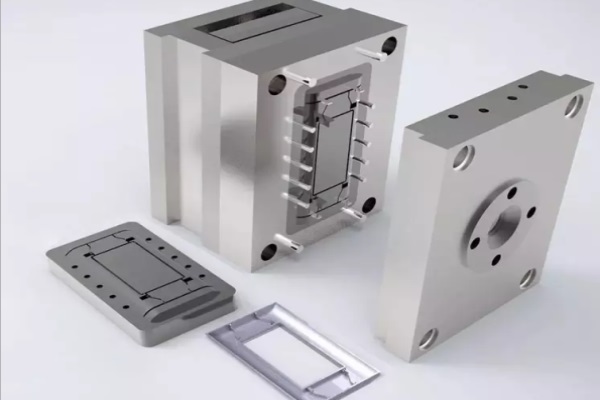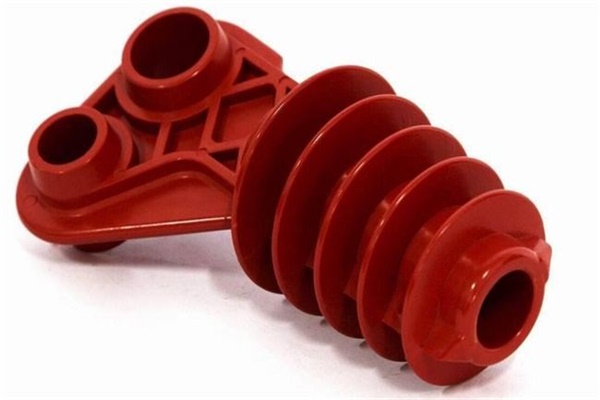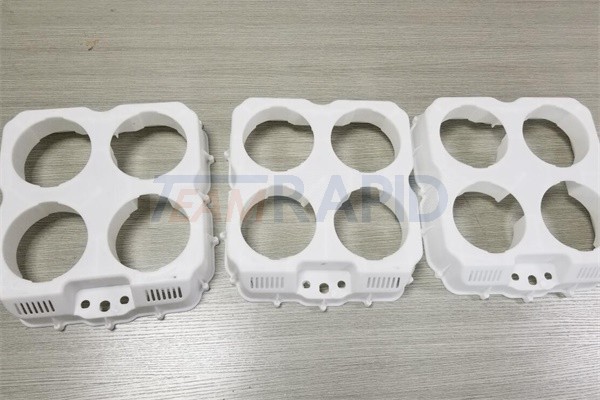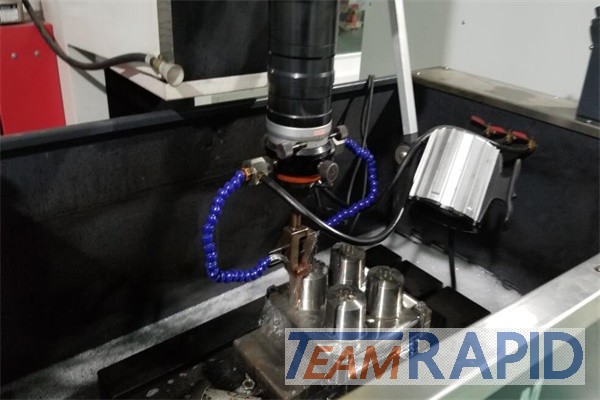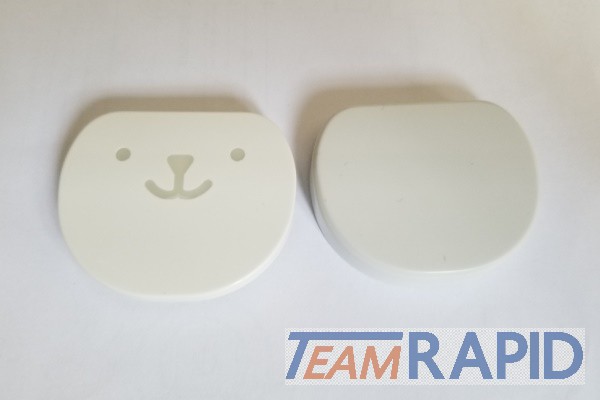Rapid tooling is also known by prototype tooling and soft tooling. Rapid tooling and injection molding allows to produce parts quickly and more cost-effectively. Rapid tooling is a group to technologies to build tooling fast, cost-effectively and efficiently compared to traditional manufacturing processes.
Traditional tooling is commonly created out of durable metals by machining and metal casting. Traditional tooling is expensive and more suitable for high volume production. When it is used for tooling iterations or create tooling which is used to produce parts in low volume, price and production timelines will increase.
Rapid tooling allows manufacturers to validate design and material choices before running into mass production to accelerate part development and launch parts to market quickly. Rapid tooling allows manufacturers to use real production grade materials to evaluate how the parts will act in the real world. Rapid tooling also allow manufacturers to test the new products in the market, provide a wide range of parts or customized parts accordingly to customer needs.
TEAM Rapid applies rapid tooling technology to serve our customers low-volume to mass production needs. In order to provide the best solution to our customers, we have 3 main tooling methods:
1. Rapid Prototype Tooling: tool life time ups to 5,000 shots for prototyping and low volume production.
2. Rapid bridge tooling: tool life time ups to 100,000 shots for medium volume production.
3. Rapid production tooling: tool life time ups to 1,000,000 + shots for mass production.
Our experienced sales engineers according to your parts’ structure and on-demanded quantities to give you professional suggestions. We aim to offer high quality parts at minimum cost, request
Today, we will talk about rapid manufacturing methods offered by TEAM Rapid, if you are looking for tooling China, contact us today.
Table of Contents
What is difference between Rapid Tooling and Rapid Prototyping?
Rapid prototyping is a group to technique to build a scale model of real parts by CAD data. As these parts are normally constructed by additive fabrication techniques which is opposed to traditional method, the step is synonymous with additive manufacturing and 3D printing.
Rapid tooling create part indirectly by additive manufacturing, machining processes. Rapid tooling builds tooling like molds, dies or patterns which are used in traditional manufacturing processes to create the end parts. Rapid tooling bridges the gap between prototyping and production.
What is the difference between soft tooling and hard tooling?
Soft tooling – Using the silicone molds and the urethane casting process. Like rapid tooling, soft tooling is used in prototyping, bridge tooling and low volume production. Patterns are used to create with 3D printing.
Hard tooling is used for metal tooling. Hard tooling is created with rapid tooling method. Hard tooling is durable and deal with high volume production. The cost of hard tooling is higher compared to soft tooling or most rapid tooling methods. Hard tooling is more suitable for mass production.
What are the applications of Rapid Tooling?
Rapid tooling can be used to support traditional manufacturing processes to create plastic, silicone or rubber parts, composites and metal parts.
1. Production for plastic parts
Injection molding, thermoforming, casting, overmolding and insert molding, compression molding.
2. Production for silicone or rubber parts
Injection molding, casting, compression molding and overmolding.
3. Production for composite
Thermoforming, compression molding and forming.
4.Production for metal parts
Casting and sheet metal forming.
Rapid Tooling Applied in Rapid Manufacturing
There are two different rapid tooling methods which include direct and indirect tooling. Indirect tooling uses master patterns to create molds or tools that produce final parts. Direct rapid tooling uses a machine or 3D printer to produce real mold, die or tool which is used to produce the end parts.
Injection molding
Direct injection molding is a manufacturing processes to produce thermoplastic, silicone or rubber parts. As the traditional metal tooling is high cost, injection molding is the process which can benefit from rapid tooling. With the 3D printer and 3D printing material which is temperature resistant, we can create 3D printed injection molds inhouse and create functional prototypes, functional parts.
Compared to expensive metal mold, 3D printed injection molds saves time and money. 3D printed injection molding allow to create functional prototypes and low volume parts to validate design and material choices before investing in hard tooling.
SLA 3D printing is a cost-effective alternative to machining steel or aluminum molds. SLA 3D printed parts can withstand the heat and pressure of injection molding process as the materials are heat resistant. But the molding volume is small, if you need higher or even much more volume parts, the metal mold is a better choice.
Low thermoforming
Thermoforming is a manufacturing process which embraces all ways to from heated sheets of plastic. For example, vacuum forming and pressure forming. Thermoforming processes allows to create parts from a wide range of thermoplastic materials and composites.
Rapid tooling can create thermoforming molds, it is fast turnaround and inexpensive for low volume, custom parts and prototype designs. The tooling offer design freedom to create complex and intricate molds.
Overmolding and insert molding
Rapid tooling can be employed for molding plastic, silicone, or rubber parts and overmolding inserts. Engineers’ prototypes use the insert and overmolded devices in serval day by rotating through rapid mold. Silicone rubber of a prototype is curing, the next can be demolded and prepared for the next fill. The demolded prototypes are finished and cleaned in parallel.
Compression molding
Compression molding can be used to produce thermoplastic, silicone, rubber and composite parts. Rapid tooling is the fastest and cheapest way to create mold for parts in small and medium size. With CAD software, reprinted and tested, iterations can be made quickly. It is used for compression molds for heatless applications.
Casting
Indirect investment casting, direct investment casting, pewter casting, sand casting with 3D printing patterns capitalizes on the 3D printing speed and flexibility. Casted metal parts by 3D printed rapid tooling can be created in less time and lower cost compared to metal 3D printing.
3D printers provide high precision and a wide range of material which is suitable for casting workflows and can produce metal parts at cheaper cost. It offers more design freedom and less time compared to traditional methods. Direct investment casting patterns are carved by machines or hand when the part is a one off or only a handful of units. Like investment casting, 3D printing can create patterns for sand casting. 3D printing allows to create complex shape and go from digital design to casting.
Sheet metal forming
Rapid tooling presents properties for sheet metal forming. Because of a wide range of materials with different properties, choosing a suitable resin can optimize the forming results. Plastic tooling eliminates a polishing step as the plastic dies will not mark the metal sheet.
3D printing
3D print is an affordable way to create rapid tooling for a wide range of applications. Direct and indirect rapid tooling leverages 3D print to develop functional tools like mold, die and patterns for traditional manufacturing processes.
SLA 3D printer provide versatile solution for tooling. SLA 3D printed parts are precise, watertight. It has a smooth finish which is ideal for mold and replicate details for molds and patterns which are complex.
SLA 3D printing has made in-house rapid tooling accessible. A reasonable budget can be set up by a 3D printing workstation. SLA 3D printing allows to produce rapid tooling in hours and iterate design quicker than other processes.
Get stared with rapid tooling
Rapid tooling with traditional manufacturing process allow to enhance the production process by increasing flexibility, agility, scalability and cost efficiency. Should you have any questions about China tooling, contact us to get started. Our experienced sales engineers according to your parts’ structure and on-demanded quantities to give you professional suggestions. We aim to offer high quality parts at minimum cost. Contact us today to learn more now!
